 |
| June 20, 2017 | Volume 13 Issue 23 |
Mechanical News & Products
Designfax weekly eMagazine
Archives
Partners
Manufacturing Center
Product Spotlight
Modern Applications News
Metalworking Ideas For
Today's Job Shops
Tooling and Production
Strategies for large
metalworking plants
hyperMILL 2024 CAD/CAM software suite
 OPEN MIND Technologies has introduced its latest hyperMILL 2024 CAD/CAM software suite, which includes a range of powerful enhancements to its core toolpath capabilities, as well as new functionality for increased NC programming efficiency in applications ranging from 2.5D machining to 5-axis milling. New and enhanced capabilities include: Optimized Deep Hole Drilling, a new algorithm for 3- and 5-axis Rest Machining, an enhanced path layout for the 3D Plane Machining cycle, better error detection, and much more.
OPEN MIND Technologies has introduced its latest hyperMILL 2024 CAD/CAM software suite, which includes a range of powerful enhancements to its core toolpath capabilities, as well as new functionality for increased NC programming efficiency in applications ranging from 2.5D machining to 5-axis milling. New and enhanced capabilities include: Optimized Deep Hole Drilling, a new algorithm for 3- and 5-axis Rest Machining, an enhanced path layout for the 3D Plane Machining cycle, better error detection, and much more.
Learn more.
One-part epoxy changes from red to clear under UV
 Master Bond UV15RCL is a low-viscosity, cationic-type UV-curing system with a special color-changing feature. The red material changes to clear once exposed to UV light, indicating that there is UV light access across the adhesive material. Although this change in color from red to clear does not indicate a full cure, it does confirm that the UV light has reached the polymer. This epoxy is an excellent electrical insulator. UV15RCL adheres well to metals, glass, ceramics, and many plastics, including acrylics and polycarbonates.
Master Bond UV15RCL is a low-viscosity, cationic-type UV-curing system with a special color-changing feature. The red material changes to clear once exposed to UV light, indicating that there is UV light access across the adhesive material. Although this change in color from red to clear does not indicate a full cure, it does confirm that the UV light has reached the polymer. This epoxy is an excellent electrical insulator. UV15RCL adheres well to metals, glass, ceramics, and many plastics, including acrylics and polycarbonates.
Learn more.
SPIROL Press-N-Lok™ Pin for plastic housings
 The Press-N-Lok™ Pin was designed to permanently retain two plastic components to each other. As the pin is inserted, the plastic backfills into the area around the two opposing barbs, resulting in maximum retention. Assembly time is quicker, and it requires lower assembly equipment costs compared to screws and adhesives -- just Press-N-Lok™!
The Press-N-Lok™ Pin was designed to permanently retain two plastic components to each other. As the pin is inserted, the plastic backfills into the area around the two opposing barbs, resulting in maximum retention. Assembly time is quicker, and it requires lower assembly equipment costs compared to screws and adhesives -- just Press-N-Lok™!
Learn more about the new Press-N-Lok™ Pin.
Why hybrid bearings are becoming the new industry standard
 A combination of steel outer and inner rings with ceramic balls or rollers is giving hybrid bearings unique properties, making them suitable for use in a wide range of modern applications. SKF hybrid bearings make use of silicon nitride (twice as hard as bearing steel) rolling elements and are available as ball bearings, cylindrical roller bearings, and in custom designs. From electric erosion prevention to friction reduction and extended maintenance intervals, learn all about next-gen hybrid bearings.
A combination of steel outer and inner rings with ceramic balls or rollers is giving hybrid bearings unique properties, making them suitable for use in a wide range of modern applications. SKF hybrid bearings make use of silicon nitride (twice as hard as bearing steel) rolling elements and are available as ball bearings, cylindrical roller bearings, and in custom designs. From electric erosion prevention to friction reduction and extended maintenance intervals, learn all about next-gen hybrid bearings.
Read the SKF technical article.
3M and Ansys train engineers on simulating adhesives
 Ansys and 3M have created an advanced simulation training program enabling engineers to enhance the design and sustainability of their products when using tapes and adhesives as part of the design. Simulation enables engineers to validate engineering decisions when analyzing advanced polymeric materials -- especially when bonding components made of different materials. Understand the behavior of adhesives under real-world conditions for accurate modeling and design.
Ansys and 3M have created an advanced simulation training program enabling engineers to enhance the design and sustainability of their products when using tapes and adhesives as part of the design. Simulation enables engineers to validate engineering decisions when analyzing advanced polymeric materials -- especially when bonding components made of different materials. Understand the behavior of adhesives under real-world conditions for accurate modeling and design.
Read this informative Ansys blog.
New FATH T-slotted rail components in black from AutomationDirect
 Automation-Direct has added a wide assortment of black-colored FATH T-slotted hardware components to match their SureFrame black anodized T-slotted rails, including: cube connectors (2D and 3D) and angle connectors, joining plates of many types, brackets, and pivot joints. Also included are foot consoles, linear bearings in silver and black, cam lever brakes, and L-handle brakes. FATH T-slotted hardware components are easy to install, allow for numerous T-slotted structure configurations, and have a 1-year warranty against defects.
Automation-Direct has added a wide assortment of black-colored FATH T-slotted hardware components to match their SureFrame black anodized T-slotted rails, including: cube connectors (2D and 3D) and angle connectors, joining plates of many types, brackets, and pivot joints. Also included are foot consoles, linear bearings in silver and black, cam lever brakes, and L-handle brakes. FATH T-slotted hardware components are easy to install, allow for numerous T-slotted structure configurations, and have a 1-year warranty against defects.
Learn more.
Weird stuff: Moon dust simulant for 3D printing
 Crafted from a lunar regolith simulant, Basalt Moon Dust Filamet™ (not a typo) available from The Virtual Foundry closely mirrors the makeup of lunar regolith found in mare regions of the Moon. It enables users with standard fused filament fabrication (FFF) 3D printers to print with unparalleled realism. Try out your ideas before you go for that big space contract, or help your kid get an A on that special science project.
Crafted from a lunar regolith simulant, Basalt Moon Dust Filamet™ (not a typo) available from The Virtual Foundry closely mirrors the makeup of lunar regolith found in mare regions of the Moon. It enables users with standard fused filament fabrication (FFF) 3D printers to print with unparalleled realism. Try out your ideas before you go for that big space contract, or help your kid get an A on that special science project.
Learn more.
Break the mold with custom injection molding by Rogan
 With 90 years of industry experience, Rogan Corporation possesses the expertise to deliver custom injection molding solutions that set businesses apart. As a low-cost, high-volume solution, injection molding is the most widely used plastics manufacturing process. Rogan processes include single-shot, two-shot, overmolding, and assembly. Elevate your parts with secondary operations: drilling and tapping, hot stamping, special finishes, punch press, gluing, painting, and more.
With 90 years of industry experience, Rogan Corporation possesses the expertise to deliver custom injection molding solutions that set businesses apart. As a low-cost, high-volume solution, injection molding is the most widely used plastics manufacturing process. Rogan processes include single-shot, two-shot, overmolding, and assembly. Elevate your parts with secondary operations: drilling and tapping, hot stamping, special finishes, punch press, gluing, painting, and more.
Learn more.
World's first current-carrying fastening technology
 PEM® eConnect™ current-carrying pins from Penn-Engineering provide superior electrical connections in applications that demand high performance from internal components, such as automotive electronics. This first-to-market tech provides repeatable, consistent electrical joints and superior installation unmatched by traditional fastening methods. Features include quick and secure automated installation, no hot spots or poor conductivity, and captivation options that include self-clinching and broaching styles.
PEM® eConnect™ current-carrying pins from Penn-Engineering provide superior electrical connections in applications that demand high performance from internal components, such as automotive electronics. This first-to-market tech provides repeatable, consistent electrical joints and superior installation unmatched by traditional fastening methods. Features include quick and secure automated installation, no hot spots or poor conductivity, and captivation options that include self-clinching and broaching styles.
Learn more about eConnect pins.
New interactive digital catalog from EXAIR
 EXAIR's latest catalog offers readers an incredible source of innovative solutions for common industrial problems like conveying, cooling, cleaning, blowoff, drying, coating, and static buildup. This fully digital and interactive version of Catalog 35 is designed for easy browsing and added accessibility. Customers can view, download, print, and save either the full catalog or specific pages and sections. EXAIR products are designed to conserve compressed air and increase personnel safety in the process. Loaded with useful information.
EXAIR's latest catalog offers readers an incredible source of innovative solutions for common industrial problems like conveying, cooling, cleaning, blowoff, drying, coating, and static buildup. This fully digital and interactive version of Catalog 35 is designed for easy browsing and added accessibility. Customers can view, download, print, and save either the full catalog or specific pages and sections. EXAIR products are designed to conserve compressed air and increase personnel safety in the process. Loaded with useful information.
Check out EXAIR's online catalog.
5 cost-saving design tips for CNC machining
 Make sure your parts meet expectations the first time around. Xometry's director of application engineering, Greg Paulsen, presents five expert tips for cutting costs when designing custom CNC machined parts. This video covers corners and radii, designing for deep pockets, thread depths, thin walls, and more. Always excellent info from Paulsen at Xometry.
Make sure your parts meet expectations the first time around. Xometry's director of application engineering, Greg Paulsen, presents five expert tips for cutting costs when designing custom CNC machined parts. This video covers corners and radii, designing for deep pockets, thread depths, thin walls, and more. Always excellent info from Paulsen at Xometry.
View the video.
What can you secure with a retaining ring? 20 examples
 From the watch dial on your wrist to a wind turbine, no application is too small or too big for a Smalley retaining ring to secure. Light to heavy-duty loads? Carbon steel to exotic materials? No problem. See how retaining rings are used in slip clutches, bike locks, hip replacements, and even the Louvre Pyramid.
From the watch dial on your wrist to a wind turbine, no application is too small or too big for a Smalley retaining ring to secure. Light to heavy-duty loads? Carbon steel to exotic materials? No problem. See how retaining rings are used in slip clutches, bike locks, hip replacements, and even the Louvre Pyramid.
See the Smalley design applications.
Load fasteners with integrated RFID
 A crane, rope, or chain may be required when something needs lifting -- plus anchoring points on the load. JW Winco offers a wide range of solutions to fasten the load securely, including: lifting eye bolts and rings (with or without rotation), eye rings with ball bearings, threaded lifting pins, shackles, lifting points for welding, and more. Some, such as the GN 581 Safety Swivel Lifting Eye Bolts, even have integrated RFID tags to clearly identify specific lifting points during wear and safety inspections and manage them digitally and without system interruption.
A crane, rope, or chain may be required when something needs lifting -- plus anchoring points on the load. JW Winco offers a wide range of solutions to fasten the load securely, including: lifting eye bolts and rings (with or without rotation), eye rings with ball bearings, threaded lifting pins, shackles, lifting points for welding, and more. Some, such as the GN 581 Safety Swivel Lifting Eye Bolts, even have integrated RFID tags to clearly identify specific lifting points during wear and safety inspections and manage them digitally and without system interruption.
Learn more.
Couplings solve misalignments more precisely with targeted center designs
 ALS Couplings from Miki Pulley feature a simplistic, three-piece construction and are available in three different types for more precisely handling parallel, angular, or axial misalignment applications. The key feature of this coupling design is its center element. Each of the three models has a center member that has a unique and durable material and shape. Also called a "spider," the center is designed to address and resolve the type of misalignment targeted. Ideal for unidirectional continuous movement or rapid bidirectional motion.
ALS Couplings from Miki Pulley feature a simplistic, three-piece construction and are available in three different types for more precisely handling parallel, angular, or axial misalignment applications. The key feature of this coupling design is its center element. Each of the three models has a center member that has a unique and durable material and shape. Also called a "spider," the center is designed to address and resolve the type of misalignment targeted. Ideal for unidirectional continuous movement or rapid bidirectional motion.
Learn more.
What is 3D-MID? Molded parts with integrated electronics from HARTING
 3D-MID (three-dimensional mechatronic integrated devices) technology combines electronic and mechanical functionalities into a single, 3D component. It replaces the traditional printed circuit board and opens up many new opportunities. It takes injection-molded parts and uses laser-direct structuring to etch areas of conductor structures, which are filled with a copper plating process to create very precise electronic circuits. HARTING, the technology's developer, says it's "Like a PCB, but 3D." Tons of possibilities.
3D-MID (three-dimensional mechatronic integrated devices) technology combines electronic and mechanical functionalities into a single, 3D component. It replaces the traditional printed circuit board and opens up many new opportunities. It takes injection-molded parts and uses laser-direct structuring to etch areas of conductor structures, which are filled with a copper plating process to create very precise electronic circuits. HARTING, the technology's developer, says it's "Like a PCB, but 3D." Tons of possibilities.
View the video.
Boom Supersonic, Stratasys partner to speed supersonic aircraft development with 3D printing; Stratasys unveils special aerospace machine
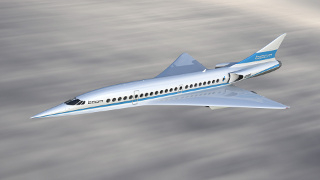
3D-printing and additive manufacturing solutions company Stratasys and supersonic civilian aircraft company Boom recently announced a significant technical partnership to bring the commercial airline industry one step closer toward routine supersonic travel.
Aimed at shaping the future of high-speed aviation, this three-year agreement was signed to help Boom accelerate production of advanced tooling and production-grade aircraft parts based on Stratasys FDM 3D-printing technology.
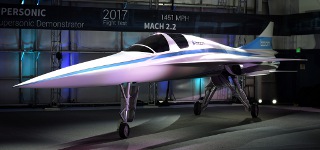
Additive manufacturing could enable unmatched design freedom and production speed of Boom's XB-1 supersonic demonstrator.
By leveraging the design freedom, production speed, and heightened cost efficiencies of additive manufacturing, Boom plans for the first flight of XB-1, their supersonic demonstrator, to take place next year. The company is deploying Stratasys FDM-based Fortus 450mc and F370 3D Printers. Both are designed to produce on-demand parts leveraging production-grade thermoplastics, as well as advanced manufacturing tools that perform even under aviation's most challenging environments.
Boom's supersonic airliner aims to fly 2.6 times faster than any other aircraft on the market today. Accelerating to 1,451 mph, the plane could reduce typical New York-to-London flight times of 7 hr to just over 3 hr.
VIDEO: Boom XB-1 supersonic demonstrator -- behind the scenes.
"Supersonic flight has existed for over 50 years, but the technology hasn't existed to make it affordable for routine commercial travel. Today's significant advances in aerodynamics, engine design, additive manufacturing, and carbon fiber composite materials are transforming the industry at all levels. Additive manufacturing helps accelerate development of a new generation of aircraft," said Blake Scholl, Founder and CEO of Boom. "Stratasys now becomes a key catalyst in our design and production processes, helping to transform the future of aviation through the power of 3D printing."
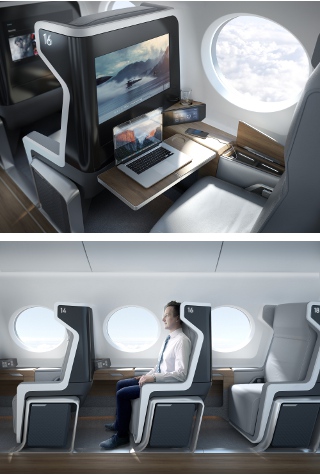
Boom aircraft interior.
The agreement will allow Boom to leverage Stratasys 3D-printing solutions, materials, and expert services. The 3D-printing solutions will advance speed, cost savings, and performance across critical engineering and manufacturing processes at its headquarters in Denver, CO.
"Stratasys' engineering-grade, high-efficiency 3D-printing solutions are perfectly suited for producing the complex part designs and custom manufacturing tools this industry demands," said Rich Garrity, president of Americas for Stratasys.
New Stratasys Aerospace Certification package
At the Paris Airshow this week, Stratasys is also introducing the Fortus 900mc Aircraft Interiors Certification Solution -- a new 3D-printing solution based on its Fortus 900mc Production 3D Printer for producing aircraft interior parts that meet stringent FAA and EASA certification requirements.
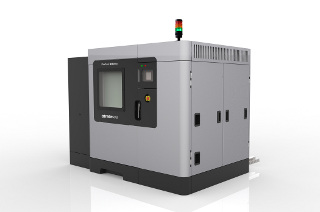
A new edition of the Fortus 900mc Production 3D Printer is featured in Stratasys' new Aircraft Interiors Certification Solution.
The solution consists of ULTEM 9085 resin, which is a strong, lightweight thermoplastic meeting aerospace flame, smoke, and toxicity (FST) regulations (FAR 25.863), and a new edition of the Fortus 900mc Production 3D Printer with specialized hardware and software designed to deliver highly repeatable mechanical properties.
This solution is now undergoing a qualification program under FAA oversight at the National Center for Advanced Materials Performance (NCAMP), part of the National Institute of Aviation Research (NIAR) at Wichita State University. Stratasys will assist customers in qualifying the Fortus 900mc Aircraft Interiors Certification Solution for equivalency with the NCAMP statistical dataset. Leveraging this first-of-its-kind NCAMP qualification of a 3D-printing process removes complexity from achieving FAA and EASA certification, helping aerospace organizations get more parts certified for flight, faster.
VIDEO: Stratasys: Aircraft Interiors Certification Solution.
"The first part that you make has to be equivalent to the hundredth part, to the thousandth part, to the part you make 10 years from now in order to be good enough to be certified for the FAA. And that's what's so powerful about the NCAMP process," said Paul Jonas, Director Technology Development, Special Programs, Wichita State University, National Institute for Aviation Research (NIAR).
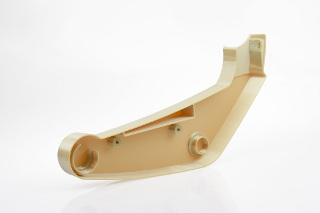
Aircraft armrest component manufactured with ULTEM 9085 material on Stratasys Fortus 900mc.
The ability to produce parts with repeatable characteristics and consistent quality is a key factor to the increased adoption of 3D printing in the multi-billion dollar aircraft interior parts segment.
"Until now, the process of achieving FAA certification for 3D printing has been limiting the adoption of additive manufacturing in aviation. There have been limited specialized solutions and statistical datasets available to support this complex process. With the new Stratasys Fortus 900mc Aircraft Interiors Certification Solution, we are removing major obstacles and making it much easier to 3D print airworthy parts, improving repeatability and performance," said Scott Sevcik, Head of Aerospace, Defense and Automotive Solutions, Stratasys.
3D printing aircraft interior parts can have key inherent benefits for both supply-chain efficiency and for the product offering of aircraft interior manufacturers. With a qualified process for producing 3D-printed interior parts, manufacturers can differentiate passenger experience with low-volume, unique elements tailored to end-customer styles or needs, as well as design lighter-weight components through the efficiency of additive design.
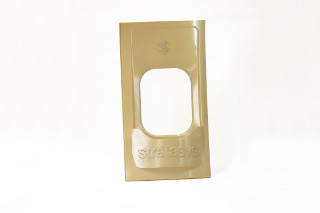
Aircraft interior window panel manufactured with ULTEM 9085 material on Stratasys Fortus 900mc.
In the Maintenance, Repair, and Overhaul (MRO) segment, the impact on supply-chain efficiency is critical to profitability. Airlines and operators keep substantial inventories of spare parts to keep aircraft in service, frequently resulting in decades-long inventory expense on parts that may never be used. By 3D printing certified parts on-demand, airlines and MROs can both reduce inventory and eliminate inventory obsolescence.
The new Stratasys Fortus 900mc Aircraft Interiors Certification Solution provides material and process traceability for compliance with major global airworthiness regulations. The qualification test program is underway now and is planned to be completed by September 2017, with publication of the final NCAMP qualification report to follow. The solution is available for pre-order and will be widely released at the conclusion of the test program.
Many leading aerospace companies are today using Stratasys 3D printing to design prototype parts, produce final flight parts, and create manufacturing aids, including Airbus, NASA, and United Launch Alliance.
Source: Stratasys
Published June 2017
Rate this article
View our terms of use and privacy policy

